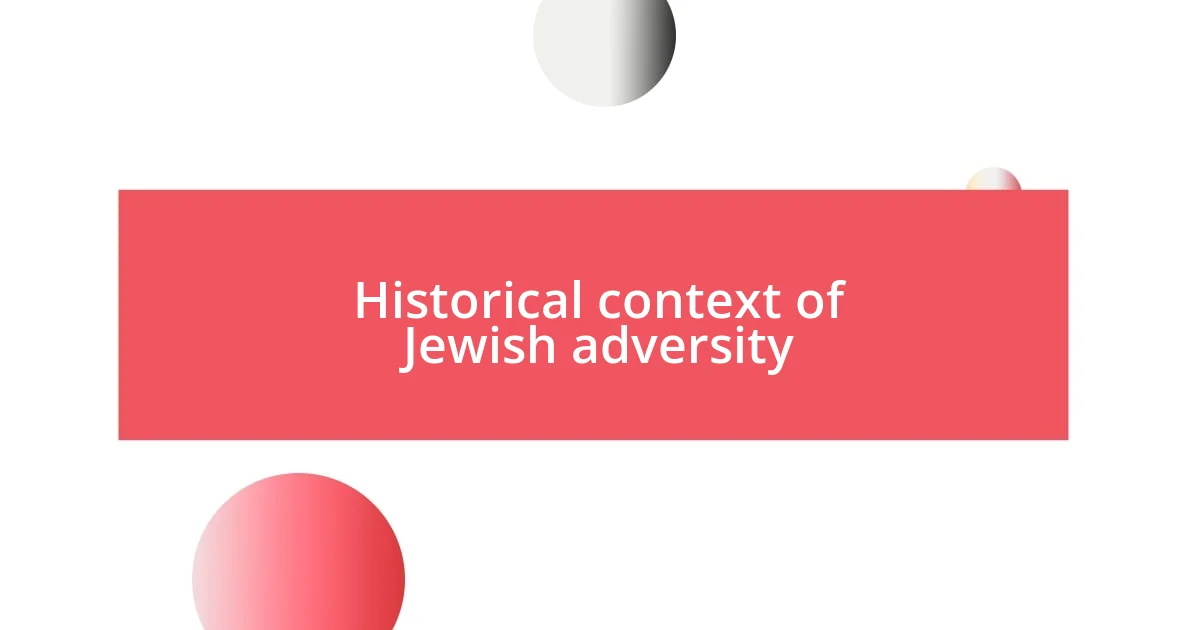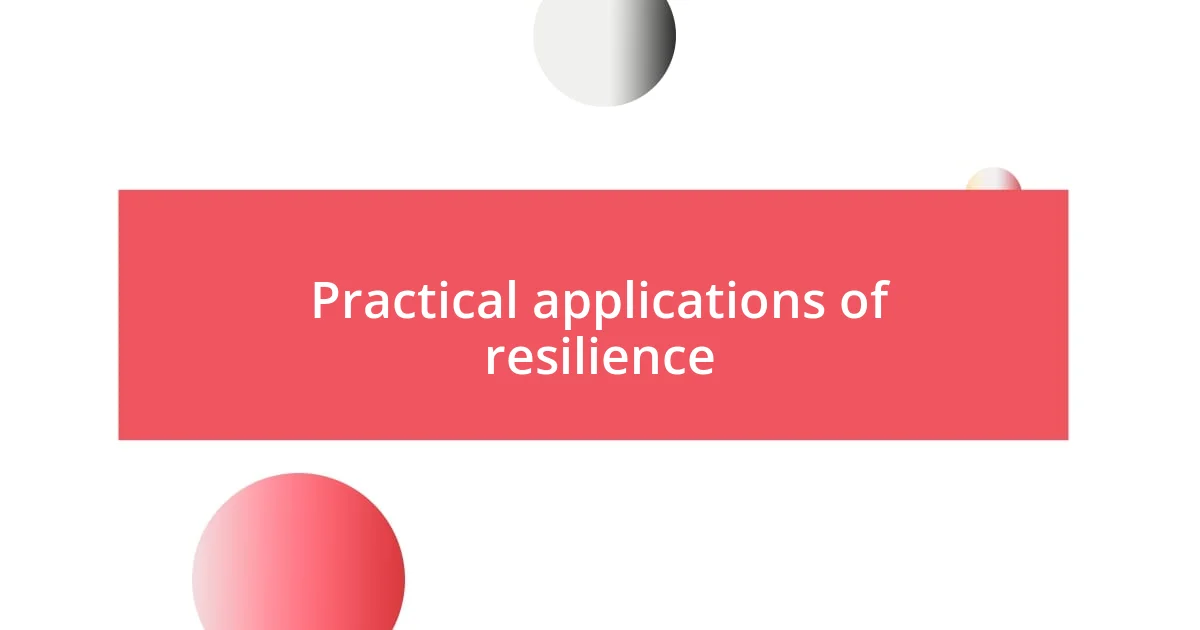Key takeaways:
- Jewish resilience is deeply rooted in communal support, adaptability, and a strong sense of identity, allowing individuals to thrive despite adversity.
- Historical events, including the destruction of temples and the Holocaust, have shaped Jewish identity, instilling lessons of perseverance and the importance of cultural preservation.
- Inspiring stories of resilience, such as those of Viktor Frankl and Anne Frank, highlight the power of perspective and community in overcoming challenges and fostering hope.

Understanding Jewish resilience
When I think about Jewish resilience, I often reflect on the stories passed down through generations, stories that blend sorrow with remarkable strength. It’s like a tapestry woven from both joy and pain, constantly reminding us of a collective history that shapes identity. How can one community endure so much and still find ways to thrive?
I remember sitting with an elderly neighbor during a summer afternoon, listening to her share experiences of her childhood during tough times. From her unwavering spirit, I learned that resilience is not merely survival; it’s about thriving despite the odds. For her, lighting the Shabbat candles was not just a religious practice but a way to reclaim joy amidst chaos.
Jewish rituals and community connections often serve as anchors during challenging times. Whether through the shared experience of mourning or the joyful gatherings during holidays, every ritual plays a part in fostering strength. Have you ever considered how deeply these practices root individuals to their past while simultaneously forging a path for the future? That connection can ignite a spark of hope that transcends generations, offering a glimpse into the profound depths of resilience.

Historical context of Jewish adversity
The history of Jewish adversity is long and complex, reflecting centuries of persecution and resilience. From the Babylonian Exile in 586 BCE to the Holocaust of the 20th century, the Jewish people have faced immense challenges that tested their faith and community bonds. Each event has influenced their identity, creating a rich tapestry interwoven with themes of survival and strength.
- The destruction of the First and Second Temples led to widespread diaspora and longing for a homeland.
- The Inquisition forced many to practice their faith in secrecy, giving rise to a tradition of resilience through hidden practices.
- Pogroms in Eastern Europe, particularly in the late 19th century, fueled mass migrations and global community building.
- The Holocaust, a devastating atrocity, not only decimated lives but also sparked a renewed commitment to cultural preservation.
I remember standing in front of a Holocaust memorial during a school trip, feeling a heavy mix of sadness and strength wash over me as the stories of survival and community echoed in my mind. That experience opened my eyes to the profound connection between past and present and how each layer of adversity has shaped the Jewish identity. The lessons of perseverance stitched into the fabric of their history always resonate with me, showing that even in the darkest times, they have found ways to emerge with unyielding spirit.

Key traits of Jewish resilience
The traits of Jewish resilience are deeply rooted in communal support, adaptability, and a strong sense of identity. I’ve often observed how gatherings, whether they’re for holidays or during shiva, create a powerful sense of belonging. In my own life, attending a local Purim celebration always leaves me feeling uplifted; laughter and storytelling interweave with remembrance, illustrating the communal strength that we rely on during tough times.
Adaptability is another key aspect of Jewish resilience. I’ve often noticed how individuals creatively pivot in the face of adversity, drawing on a rich cultural history to find new paths forward. For instance, discussing the innovative ways families adapted traditional recipes during wartime reminded me of how our history encourages resourcefulness, or “tz’ruya,” which means to be resourceful in Hebrew. It’s amazing how this trait allows people to not just survive but flourish, finding joy amid uncertainty.
Moreover, the emphasis on learning and questioning reflects an enduring strength within the community. I remember discussing Jewish philosophy with a friend, marveling at how the Talmud encourages debate and discussion. This intellectual resilience cultivates a mindset that isn’t afraid to confront challenges head-on. After all, it’s the questions we ask that often lead us toward strength and understanding, helping each generation to build on the legacy of those who came before us.
| Key Trait | Description |
|---|---|
| Community Support | The importance of gathering, sharing stories, and collective strength during adversity. |
| Adaptability | The ability to creatively pivot and find new ways to thrive in challenging circumstances. |
| Intellectual Resilience | The encouragement of questioning and debate, fostering a mindset of learning and growth. |

Role of community in resilience
When I think about resilience in the Jewish community, I immediately recall the countless times I’ve felt uplifted during group gatherings, especially during celebrations like Seder or Hanukkah. The atmosphere is electric; laughter mingles with prayers, and the stories we share weave us together. Reflecting on this, I wonder: How could such unity in community during challenging times foster individual strength? It’s clear that these collective moments are vital, serving as a reminder that we’re never alone on our journey.
One poignant memory stands out for me. During a period of personal hardship, I was surrounded by friends who organized a small get-together just to support me. Their presence alone reminded me of the power of community—how simply being together can bolster courage and resilience. This experience made me realize that, within the Jewish tradition, the act of gathering is more than just socializing; it’s a powerful assertion that “we stand together, come what may.”
The role of community in resilience is not just about moral support; it also cultivates a sense of responsibility toward one another. I often find myself reflecting on our shared rituals and traditions that emphasize caring for others. Have you noticed how in Jewish culture, there’s an almost inherent expectation to be there for one another? Whether it’s preparing meals for someone in mourning or celebrating achievements together, this deep-rooted ethos of support fills the spaces where individual struggles reside, reminding each of us that resilience is best nurtured in a communal garden.

Lessons from Jewish history
Throughout Jewish history, there are profound lessons that resonate deeply with our contemporary struggles. One striking example is the resilience displayed during the destruction of the Second Temple in 70 CE. The perseverance of Jews to adapt, reinvent their customs, and continue practicing their faith—even when faced with such profound loss—reminds me of how we can find strength in our heritage. It’s as though the collective will to endure transforms pain into resilience, encouraging each generation to carry on despite challenges.
I’ve often thought about how Jewish intellectual tradition has emphasized asking questions, especially during the Passover Seder. When I participated in these discussions as a child, I felt like each question was a thread weaved into a larger tapestry of understanding. The way we engage critically with our texts not only fosters a strong sense of identity but also cultivates resilience in the face of adversity. Are we not more equipped to handle life’s challenges when we remain open to inquiry and growth?
Moreover, the tales of survival during the Holocaust serve as a potent reminder of the strength found within vulnerability. I remember a documentary I watched that highlighted stories from survivors who, despite unimaginable hardships, built vibrant communities afterward. This truth resonates deeply with me—through shared pain and collective memory, they forged new beginnings. It’s these moments that lead me to ponder: How do we, too, transform our scars into stories of resilience, ensuring that we never forget the power of unity in overcoming adversity?

Practical applications of resilience
Resilience can be practically applied in our daily lives by cultivating a mindset focused on growth and adaptability. For instance, I remember during a particularly stressful time at work when a project I led faced significant difficulties. Instead of succumbing to despair, I chose to reflect on each challenge as an opportunity to learn. This shift in perspective not only helped me navigate obstacles but also encouraged my team to adopt a similar approach. Have you ever experienced how reframing a setback as a stepping stone can create a ripple effect of positivity?
Another practical application of resilience comes from setting and maintaining personal boundaries. In my experience, I once took on too many responsibilities during a community event, leading to overwhelming stress. It was a wake-up call that taught me the importance of saying “no” when necessary. By respecting my limits, I found the strength to engage fully when I did participate. How can we better honor our own needs while still supporting those around us?
Moreover, resilience thrives through reflection and ritual. I recall a moment after a challenging year when I decided to create a personal gratitude ritual. Each week, I would jot down moments that sparked joy or gratitude, no matter how small. This practice not only strengthened my emotional intelligence but also helped me focus on the positives during tough times. Have you considered how intentional reflection might serve as a daily anchor for resilience in your own life?

Inspiring stories of resilience
The story of Viktor Frankl, a Jewish psychiatrist and Holocaust survivor, has always moved me. Despite enduring the horrors of concentration camps, he found purpose in suffering, which he articulated in his book Man’s Search for Meaning. The notion that we can choose our attitude even in the bleakest circumstances speaks volumes about resilience. Have you ever thought about the power of perspective in your own life? It’s fascinating how our mindset can redefine our experiences.
Another inspiring tale comes from the Jewish community that rebuilt in Poland after World War II. I remember learning about the flourishing cultural and educational initiatives that sprang from the ashes of destruction. They faced not only the loss of lives and homes but also the challenge of reinstating their identity. Witnessing their dedication to preserving their culture, even in the face of adversity, made me reflect on how our own communities can thrive when they gather in unity after strife. Can we learn from their commitment to nurturing hope?
Then there’s the story of Anne Frank, whose diary remains a powerful testament to the human spirit. She documented her life in hiding with such insight, humor, and hope that it speaks across generations. I often think about how she found solace in writing, turning her fear and uncertainty into a legacy. Her ability to maintain hope amidst a dire situation inspires me to discover outlets for my own emotions during tough times. Wouldn’t it be remarkable if we all shared our stories, transforming our struggles into a source of inspiration for others?













